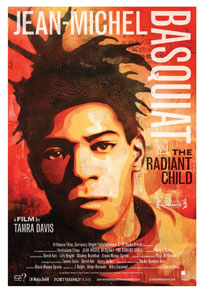Jean-Michel Basquiat: The Radiant Child
 From Wikipedia the free encyclopedia
From Wikipedia the free encyclopedia
| Jean-Michel Basquiat: The Radiant Child | |
|---|---|
 Theatrical release poster | |
| Directed by | Tamra Davis |
| Produced by |
|
| Starring | Jean-Michel Basquiat |
| Cinematography |
|
| Edited by | Alexis Manya Spraic |
| Music by | |
Production companies |
|
| Distributed by | Arthouse Films |
Release dates |
|
Running time | 90 minutes |
| Country | United States |
| Language | English |
Jean-Michel Basquiat: The Radiant Child is a 2010 documentary film directed by Tamra Davis. It crosscuts excerpts from Davis' on-camera interview with the artist Jean-Michel Basquiat and anecdotes from his friends and associates. The film was shown at the Sundance Film Festival in 2010.[1]
Background
[edit]Tamra Davis was working in a Los Angeles art gallery in 1986 when she filmed an interview with her friend, Jean-Michel Basquiat.[2] After Basquiat's death from a heroin overdose in 1988, Davis stored the footage away. In 2008, Davis was encouraged by gallerists at the Museum of Contemporary Art to do something with the footage.[3] She began interviewing friends and associates of Basquiat's and pieced together a documentary.[2] The film is titled after an article about Basquiat written by art critic Rene Ricard for Artforum in 1981.[4]
Synopsis
[edit]In the beginning of his 10-year career, Jean-Michel Basquiat was known for his graffiti art under the alias SAMO in Manhattan's Lower East Side in the late 1970s. He sold his first painting to Debbie Harry for $200, dated Madonna, and became a close friend and collaborator of Andy Warhol's.[1] Basquiat was launched into international stardom for his bebop-influenced neoexpressionist work. However, soon his cult status began to overshadow his art.[5] As a successful black artist, Basquiat was constantly confronted by racism and misconceptions. The Radiant Child draws from insider interviews and archival footage of Basquiat's telling his story in his own words.[1]
People interviewed
[edit]- Julian Schnabel
- Larry Gagosian
- Bruno Bischofberger
- Tony Shafrazi
- Fab Five Freddy
- Deitch Projects
- Glenn O'Brien
- Maripol
- Thurston Moore
- Nelson George
- Kai Eric
- Nicholas Taylor
- Fred Hoffmann
- Michael Holman
- Diego Cortez
- Annina Nosei
- Suzanne Mallouk
- Rene Ricard
- Kenny Scharf
- Robert Farris Thompson
- Kelle Inman
Reviews
[edit]The film received positive reviews, however, critics noted that it doesn’t fully explore why Basquiat's work was so "innovative in the New York art scene of the 1980s."[6] Slant Magazine wrote that "you see the paintings and hear people praise them, without the space to consider them in between, " adding: "The film's a decent introduction to a man who walked the world of SoHo, CBGB, and Andy Warhol's final days, but the more you know going into the movie, the more you sense it leaving out."[7]
The Hollywood Reporter wrote: "Naturally, the doc is well illustrated with examples of Basquiat’s work, some of which are little-seen. But even those who dispute his place in art history should come away with a feeling for the man whose brief career is a textbook example of a flame burning too bright to last."[8]
The Artforum wrote: "The movie gives a sense of how driven he was, how it seemed as if he aimed, by sheer volume, to assure himself a place in the pantheon of twentieth-century painters, when in fact he achieved that position by virtue of a necessarily smaller number of masterpieces, produced in the early and late stages of his heartbreakingly short career."[9]
References
[edit]- ^ a b c "Sundance '10 | Tamra Davis Revisits the Life of Jean-Michel Basquiat". IndieWire. January 21, 2010. Retrieved 2021-08-28.
- ^ a b "Q&A: Director Tamra Davis Talks Basquiat and Her New Documentary". The FADER. Retrieved 2021-08-28.
- ^ Meter, William Van (2010-07-19). "Asked & Answered | Tamra Davis". T Magazine. Retrieved 2021-08-28.
- ^ Kane, James (October 14, 2010). "Review: Jean-Michel Basquiat: The Radiant Child". St. Louis Magazine. Retrieved 2021-08-30.
- ^ Pinnington, Mike (January 25, 2018). "Close-Up on Tamra Davis's "Jean-Michel Basquiat: The Radiant Child"". MUBI. Retrieved 2021-08-30.
- ^ Kendricks, Neil (February 7, 2010). "Art world makes a run at Sundance Film Festival". The San Diego Union-Tribune.
- ^ Cutler, Aaron (July 19, 2010). "Review: Jean-Michel Basquiat: The Radiant Child". Slant Magazine. Retrieved 2021-08-30.
- ^ AP (2010-10-14). "Jean-Michel Basquiat: The Radiant Child — Film Review". The Hollywood Reporter. Retrieved 2021-08-30.
- ^ Taubin, Amy (July 20, 2010). "Amy Taubin on Jean-Michel Basquiat: The Radiant Child". Artforum. Retrieved 2021-08-30.